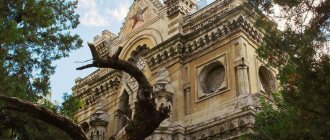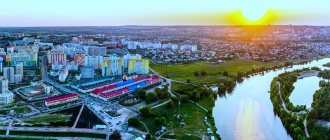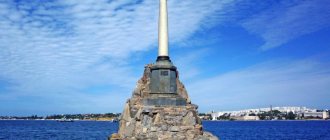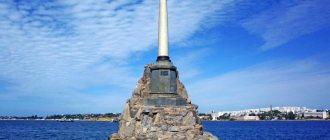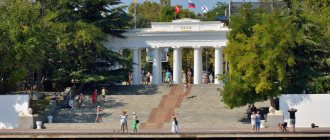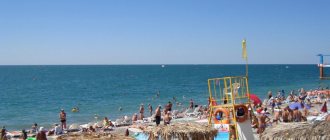Good maps of Kaliningrad with attractions that can be downloaded and printed are rare on the Internet. These are usually poor quality images where it is difficult to see anything. This collection contains tourist maps of Kaliningrad and the Kaliningrad region in good quality, as well as routes for walking around the city, guides and an interactive map with hotel locations.
Read also: Best hotels in Kaliningrad
Kant Island
Kant Island is located in the center of Kaliningrad on the Pregoli (Pregel) River. It was formed by washing the land with two branches of the river. The island is located next to another island – Oktyabrsky. The island received its name in honor of Immanuel Kant, the great scientific thinker and philosopher. Once upon a time it had completely different names in German: Vogswerder, Knipav (1327), Pregelmüne (1333), Kneiphoff.
What interesting things can you see on Fr. Kanta:
- A grave with a monument dedicated to the German philosopher Kant.
- The cathedral with a town hall, which now hosts services of two religious organizations (Evangelical and Orthodox), has its own museum, as well as an ancient organ, which periodically sounds under the hands of different masters. Address: st. Kanta, 1.
- Sculpture Park. There are monuments and pedestals to famous personalities - poets, composers, writers, politicians.
- Arboretum. Beautiful and well-groomed plants, of which there are about 1030 species, not only delight the eye, but amaze with their geometrically correct arrangement.
The last two objects - the arboretum and the Sculpture Park, are located at the address: st. Kant, 26. The grave of the German thinker with monuments in his honor is located near the Cathedral.
Kneiphof was partially destroyed during the Second World War. It was restored by the Soviet authorities after Koenigsberg became Kaliningrad. For example, the cathedral was restored in 1998. The first trestle bridge was built in 1970.
Monuments
List of famous monuments that may be of interest to tourists, with a brief description:
- The monument to Duke Albrecht was erected in 1891 next to the Cathedral.
- Monument to soldiers - internationalists. Located in Yunost Park. It was opened in 1998.
- Monument to Hermann Klaass was built in 1913. Dedicated to the founder of the zoo.
- Monument to Julius Rupp. Dedicated to a rebellious preacher who renounced the church and opened an evangelical community.
- The monument to Peter I is located at the headquarters of the Baltic Fleet. Dedicated to the founder of the Russian fleet.
- Monument to M.I. Kalinin , after whom the city was named, was created in 1946.
Ancient castles
Another highlight of Kaliningrad for tourists is a castle, of which there are dozens. Especially if you take into account the entire region, and not just one city. Some buildings have not survived at all, while others appear only in the form of ruins. But there are also those that are still well preserved or have been restored.
Popular excursions in the city:
- Fall in love with Kaliningrad in 3 hours
- A walk through time: old and new Kaliningrad
- The spirit of old Königsberg
Arriving in Kaliningrad, you can visit the following 9 preserved sites of antiquity:
- Waldau. Erected in 1258, it is a monument to the Teutonic Order. Located in the village of Nizovye on Kaliningradskaya street, no. 20-A. You can arrive from the regional center on route No. 110. In your own (or rented) car, you should move along the A-229 highway and turn off near Rodniki.
Waldau Castle
Popular excursions to the castle:
- Knight's castles of East Prussia
- Journey to the castles of the Teutonic Order
- Georgenburg. Year of construction: 1337. Initially, it was not intended for defense. Therefore, it was not constantly strengthened in the walls and gates, compared to other castles. The castle is not open to tourists because several families live there. Address: Kaliningrad region, Chernyakhovsky district, Chernyakhovsk city, Tsentralnaya street, house No. 4.
- Insterburg. It was built in 1336. It is classified as a water castle because there is a moat with water around it, there is a stream and a mill was installed. The castle was a bastion and a military installation. The location is the same as that of Georgenburg Castle, only Zamkovaya Street, building 1.
- Labiau (1277-1280). Received its name in 1330. Today this object is under state protection (since 1960) as a cultural heritage. Belongs to the Russian Orthodox Church (ROC). Open to visitors as a museum and puppet theater. Address: Kaliningrad region, Polessk, st. Kaliningradskaya, 1.
- Neuhausen. The structure dates back to the 13th century. Located 7 km from the regional center. The architectural appearance is not as refined as other castles. It was rebuilt in the 14th century. Today the castle is a rectangle as a defensive fortification. Address: Kaliningrad region, Guryevsk, st. Zarechnaya, 3.
- Preussisch-Eylau (1325). It is a cultural monument and has been protected by the state since 2007. The condition is deplorable, so we can say that it has hardly survived. Address: Kaliningrad region, Bagrationovsk, st. Brick, 17.
- Tapiau (1265-1258). Since the 15th century it has been used as a prison. Now it has been significantly rebuilt while maintaining the overall appearance. Address: Kaliningrad region, Gvardeysk, st. Dzerzhinsky, 12.
- Taplaken (1336). Initially it was a fortress, after which it was rebuilt into a castle (1530). But the structure retained its shape - a rectangular fortified building with an internal rectangular courtyard, a gable roof, and no turrets. Today the castle is in a dilapidated state. You can inspect it yourself. Address: Kaliningrad region, Gvardeisky municipality, Taplaki village, st. Mira, 14.
- Shaaken (approximately 1258-1261). It is dilapidated and tourists can explore it on their own. Address: Kaliningrad region, Guryevsky district, Nekrasovo village, st. 1st Northern.
Schaaken Castle
There are also many unsurvived copies worthy of attention as historical reference. For example, Königsberg Castle, whose foundation dates back to the 13th century. Destruction in 1968. Belonged to the Teutonic Order. The city was named after this castle. In its place today there is a museum, an observation deck and part of the territory is reserved for excavations. It is customary for historians to read that it was in this castle that the Amber Room was created
Excursions around Kaliningrad
Kaliningrad (a map with addresses, contacts and opening hours of the main attractions will help the tourist make a route plan) can be visited using the services of travel agencies.
- Museum Dugout. It is a bunker that was built for the defense of the city, on the orders of Otto von Lyash, for which the museum is often called Lyash’s refuge. The museum displays various exhibits. Open seven days a week, every day from 10 am to 6 pm. A school ticket costs 50 rubles, an adult and student ticket costs 150 and 100, respectively. Children under 6 years old are admitted free of charge. Address of the bunker museum: Universitetskaya street 2A.
- Royal Gate. They are one of the few surviving ancient gates; they were built back in 1843. There is a museum on the territory, which displays exhibitions dedicated to various Prussian kings. Children under 16 years of age are admitted free of charge, a ticket for a student is 100 rubles, a regular ticket for an adult is 150 rubles. Address: Frunze Street, 112. You can get there by buses that go to the stop of the same name, namely 28, 45 and 37.
- Königsberg Castle. The castle was the residence of the Czech and Prussian kings. It has a long and unique history. Following a fire, the remains of the castle were demolished in 1968.
Address: Shevchenko street 2, near the Oktyabrskaya stop. You can get there by trolleybuses No. 7, 2 or buses No. 93, 75, 72.
https://www.youtube.com/watch?v=BGT1Ok92FDs
Legendary forts
The city of Koenigsberg-Kaliningrad, from 1255 until the end of World War II, was constantly fortified with a special system - fortifications. These forts are lined up along with gates around the city. When the second defensive ring was built, this system began to be called “the night feather bed of Koenigsberg.”
There are 17 forts in total. Of these, 12 are large objects, and 5 are small. Almost all of them have their names in honor of famous personalities. Here are the 12 largest forts:
- Stein. Name in honor of the Prussian politician (18th century). Open to the public on Sundays. Address: Kaliningrad, Moskovsky Ave., 363.
- Bronzart. Now it is private property, so it is not visited by tourists.
- King Frederick I. Now does not belong to anyone, and can be visited without purchasing tickets. Address: Kaliningrad region, Guryevsky district, Maloe Vasilkovo village.
Fort No. 3 of King Frederick I
- Gneisenau. Named after the Prussian general who became famous at the Battle of Waterloo. Visiting is allowed without purchasing tickets, on your own. Address: Kaliningrad, st. Gorky, 301.
- King Frederick William III. It serves the public as a museum, demonstrating not only the structure itself, but also military equipment. Paid entrance. Address: Kaliningrad, st. A. Nevsky, 232.
Fort No. 5 of King Frederick I
- Queen Louise. Owned by the state. Visits are limited - only the inner courtyards are subject to inspection. Address: Kaliningrad, st. Shady Alley.
- Holstein. It was named after the Duke. Serves the state as a Baltic Fleet facility closed to the public. Address: Right embankment, Kaliningrad.
- King Frederick I. The building is abandoned and dilapidated. You can visit it on your own. Address: Kaliningrad region. village Shosseinoye.
- Don. It is in disrepair. The visit is free. Address: between the villages of Laskino and Dorozhnoe, Kaliningrad region.
- Kanitz. Named after the Prussian minister. The fort is now closed to visitors. Address: Kaliningrad, st. Bolshaya Okruzhnaya (on the road to Bagrationovsk).
- Dönhoff. Closed state facility. Address: Kaliningrad, st. Energetikov, 8-A.
- Eulenburg. Military closed facility. Address: Kaliningrad, Moskovsky district, st. Energetikov, 22.
Fort No. 11 Dönhoff
City officials warn that you should be careful when exploring the dilapidated forts yourself. This is especially true for those vacationers who love to climb onto roofs or ledges in the walls of buildings. Half-collapsed bricks that crumble over time can be dangerous.
Popular excursions visiting forts:
- To the Curonian Spit through forts and castles
- Guardians of Königsberg: underground passages, forts and bastions
- In search of the forts of Kaliningrad - a quest on an SUV
Mysterious places
Here you will see truly unique places, the very name of which attracts with its mystery. This:
- Dancing Forest;
- Muller height;
- Dune Efa;
- Fishing village;
- Ancient castles, as well as many other equally fascinating attractions.
Most interesting places can be visited by car or joined one of the excursion programs. No matter which method you choose, you will have a truly unforgettable experience. But it takes a lot of time to see all the interesting sights of this region. Therefore, you should carefully study them to create your own excursion program.
So, what attractions of the Kaliningrad region should you visit first?
Curonian Spit
It stretches all the way to the border with Lithuania, dividing the Curonian Lagoon with fresh water and the Baltic Sea. The territory of this sandy coast, which is 400 m wide and 4 km long, belongs to two countries. This is a favorite vacation spot for tourists who are attracted by the unique nature of the area. The amazing combination of sand dunes, forests and meadows brings thousands of people here every year, who get the opportunity to swim in the fresh water of the Curonian Lagoon and the salty sea in one day.
There is also a national park here, where, thanks to the unique microclimate, you can find a huge variety of flora and fauna. In order for tourists to see everything they have planned, special walking paths have been created here along different routes that cover the entire territory of the reserve. This park is the very first to be founded in Russia, as well as the smallest. Despite its modest size, it offers guests a lot of entertainment: creativity competitions, charity events and various conferences are regularly held here.
Dancing Forest
This is a unique place, which is located on the Curonian strip. Walking through the small local pine forest, you will notice that the trees twist at the most incredible angles. There is a belief that here you need to walk only on special walking paths, otherwise the trees will take you to themselves. You should also not pick off their leaves, bark, or even the grass of the area.
The question of why pine trees, which always grow only straight, suddenly began to twist in this way, has still not found a scientifically proven answer. There are a variety of versions, including even alien intervention. The forest is located on the road leading to Lithuania, and you can get here either by your own car or by public transport or taxi.
Muller height
This is the name of the highest point of the largest dune of the Curonian Spit. It is named after the forester who, thanks to hard work, was able to stop the movement of the sands. With this he saved the nearby village of Rybatsky.
Now this is a place where many tourists go every year. There is a convenient path for them, along which you can enjoy the magnificent air and beautiful views of the spit. The entire road stretches 2 km, the amount of time spent will depend on how often you stop for filming. From Muller Heights you will have a magnificent view of the sea, the bay and the rescued village itself.
Dune Efa
This is the highest dune not only in the bay, but in all of Europe. You can get to its top along a wooden deck. Independent movement along the dune is strictly prohibited, but you can enjoy the beautiful panorama from one of two observation platforms.
Due to such a number of not only beautiful, but also unusual, unique places, every tourist who comes to the Kaliningrad region is worth a trip to the Curonian Lagoon.
Scenic Gate
Some gates of Kaliningrad are attached territorially to the forts, while others are installed independently. But they all had to protect the city from enemies and perform a border function.
City guests can visit the gates:
- Royal on Frunze Street, 112 - inside the museum;
- Rossgartenskie on Marshal Vasilevsky Square, 1-3 (next to the Amber Museum) - cafe “Sun Stone”.
- Friedlandskie on the street. Dzerzhinsky, 30.
- Zakheimsky on the street. Litovsky Val, 61 – there are cafes “Bread and Turka” and “StolStool” equipped inside.
- Brandenburg (Berlin) on the street. Bagrationa, 137
- Ausfalskie - inside the historical and art museum. Address: Kaliningrad, Gvardeysky Ave., 22-A.
- Railway – now this is the entrance to Victory Park. Address: Kaliningrad, Gvardeysky Ave., 30.
- Steindamsky, Hollanderbaumsky - demolished.
Architectural sights of Kaliningrad
Kaliningrad has architectural buildings that have their own history, value and are marked on the map of the city's attractions:
Royal Gate
This is one of the 7 gates built in Kaliningrad. Construction of the structure began in the 19th century. Initially, the purpose of construction was to defend the city. But their mission did not last long. The Royal Gate began to be considered a city landmark, and one of the most interesting.
They are located on Frunze Street, 112. There are bus stops near the attraction. To get to the Royal Gate, you need to get off at the Litovsky Val stop. From there there are nine buses to your destination. Arriving at the museum, you can see a wide passage, near which there are casemates. Also on the gate are portraits of famous kings and family coats of arms.
Villa Schmidt
It is considered an architectural decoration of the city. It was built in 1903 and bears the name of its first owner. The villa was built in a romantic style, which was characteristic of the 19th-20th centuries. Villa Schmidt has survived to this day in its original state.
It is located at the address: Pobedy Avenue, 24. You need to take public transport either at the M. Gvardiya stop or at Brusnichnaya. Take bus No. 24 to Pobeda Avenue and walk to Kindergarten No. 27.
Police Presidium building
The building was built in 1912. Until 1945, the political police of the Third Reich (Gestapo) were located on this site. Before the collapse of the USSR, the KGB was located in the building. The construction was done in the neo-Renaissance style. A distinctive feature of the style is the desire for symmetry, rectangular shapes with courtyards, balconies with terraces.
Also at the entrance to the building itself there are shell rock reliefs made by a famous sculptor. Located at Sovetsky Prospekt 3-5. You can get there by trolleybus No. 1, which departs from the Chkalovsky turn. Or by bus number 4, also to Tchaikovsky. The bus leaves from the Yantar Factory.
Rossgarten Gate
This is also one of the 7 gates built in Kaliningrad. They were built in 1855 as a decorative structure, but the gates were also supposed to serve a defensive function. The project was created by a famous engineer-lieutenant. During the war they were badly damaged, but they were restored.
The work of the sculptor gave the structure lightness. This is usually not typical for such structures. At the Rossgarten Gate one can observe sophistication and grace. Now this place is occupied by a restaurant. Address: Chernyakhovsky street. You can get there by taking buses from the Vasilevsky Square stop. More than 20 buses go there.
House of Soviets
A popular building that has been under construction since 1970 and is still unfinished. It is considered an unofficial symbol of Kaliningrad. The architect planned a building 28 floors high. The area around the building was planned to be beautifully arranged. But, since the soil in this place is unstable, problems arose.
Therefore, only the 21st floor was built. In the second half of the 80s. construction was stopped, but by that time the building was almost completed. In 2005, renovations were carried out, and the building began to look more modern.
But even now it is still unknown what awaits this building. Located at Shevchenko Street, 8. How to get there by transport: you need to find Stanochnaya Street and head towards Moskovsky Prospekt.
Curonian Spit – villages and national park
The Curonian Spit is a fairly narrow saber-shaped strip of land that connects Zelenogradsk in the Kaliningrad region and Klaipeda in Lithuania. Exactly in the middle of the spit there is a border post. It is washed by the Curonian Lagoon, which has more fresh water than salt water. And also the Baltic Sea on its other side.
Geographical parameters of the spit:
- length – almost 100 km (98 km);
- maximum width – 3.8 km;
- minimum width – 350-400 m.
The territory of the spit is considered unique because of its diversity of nature - plants, trees, soil types, animals and birds. Here are the most important features of the Curonian Spit:
Popular excursions on the Curonian Spit:
- National Park "Curonian Spit"
- Curonian Spit for children and adults
- A narrow strip of land that belongs to Russia, except for three villages, is called the Curonian Spit National Park.
- This is one of the most important areas for migratory birds. The migration is monitored by the specially built Fringilla bird station.
- There are three villages here - Lesnoy (formerly Zarkau), Morskoye (Pillokoppen) and Rybachy (Rossiten).
- Two popular heights, Efa and Müller, are landscaped for walking with wooden decks, climbing paths and observation decks.
- On land there is one road leading directly to Klaipeda, straight along the spit.
- The forests are original in that one has ancient trees (Royal Forest), the other has twisted tree trunks (Dancing Forest).
- The Temple of Antiquity (1873), which is now the Orthodox Church of St. Sergius of Radonezh (1999).
- There is a local history museum on site, which is open from 9:00 to 17:00, or longer if it is tourist season (May-October). Entrance fee – 100 rubles. (adult ticket), 70 rub. (children), 150 rub. (preferential – 100 rubles) when visiting the interactive site – the ethno-village of “Sambia”.
Previously, the spit was completely landscaped. Denudation and filling with sand occurred as forests were cut down in the Middle Ages. Now in some places the sand dunes are suspended by legendary figures - Muller and Ef. The length of the Müller dune is 2 km, its height is 44.5 m. The height of the Orekhovoy dune on the Efa Hill is 64 km. The ridge itself stretches 16 km in length. New species of pine trees and other plants capable of attaching roots to the sand layer were imported.
The main attractions of Kaliningrad
Every tourist who comes to Kaliningrad needs to create a visit plan in advance so as not to miss significant places in the city.
Church of the Holy Family
This landmark was erected at the beginning of the 20th century. At one time, St. Catherine's Hospital was based on its territory. At the moment, various musical and opera performances, as well as festivals, take place in the Church of the Holy Family.
Ticket prices are constantly changing, depending on the show program; you can find them on the poster or on the official website. The ticket office is open from 11 to 19. To get to the street, st. Bogdan Khmelnitsky, 61 (exact address of this attraction), you can use tram No. 3 or buses No. 64, 93.
Cathedral
One of the most striking attractions, its construction began in the 14th century. After each war it was destroyed and rebuilt again. Nowadays, various performances and organ concerts take place in the Cathedral. Tickets are divided into 3 categories: small hall, daytime, evening.
Prices for adults: from 300 to 400 rubles, for students, schoolchildren: from 150 to 250 rubles, for pensioners: 200; 150; 250 rub. for each category respectively. There are also tours of this ancient cathedral, entrance tickets for adults are 150 rubles, schoolchildren and students are 100 rubles.
For preschoolers there is a discount on free entry to any events accompanied by an adult. Address: Kanta Street, 1. You can get there by trolleybuses No. 7 and 2, as well as by buses 72, 75, 93.
Kaliningrad Zoo
On the territory of the city there is a zoo, which has a centuries-old history. The zoo is one of the oldest in Russia. Founded on the site of the Königsberg Zoo. It was decided to adapt the pavilions built near the Khufensky stream for animals.
You can see more than 2 thousand different animals there. The Kaliningrad Zoo is one of the most visited places by all tourists. On its territory there are a large number of different complexes: an aquarium, a tropical house, a terrarium. The zoo starts operating on May 1 and closes on September 15 for the entire cold period. Opening hours from 9:00 to 20:00 seven days a week.
The Terrarium and other complexes have their own opening hours and close a little earlier, so this information should be checked on the website. The zoo often hosts special events that require a separate ticket purchase. Open all year round.
Entrance prices are as follows: adult – 250 rubles. from May to September, student – 100 rubles, as well as for pensioners, school and children’s – 50 rubles. You can use Nikolai Drozdov’s audio guide completely free of charge by simply downloading the official application to your smartphone. The zoo is located at Mira Avenue, 26. You can get there by trolleybuses 2, 5, 6, as well as buses 61, 63, 72, 74, 92.
Museum of the World Ocean
The museum was established in 1990. Address: Kaliningrad, emb. Peter the Great, 1. The following facilities are open to tourists:
- The main building with an aquarium, coral exhibitions, museum exhibitions, a storage facility for the Glubina Foundation, and interactive events.
- Navy Pavilion "Cube of Water".
- The Royal Gate, which is directly related to the territory of the Museum - the exhibition "Great Embassy".
- Museum and exhibition, which is located in Svetlogorsk.
- Ships moored specifically as museum exhibits, including the submarine and icebreaker Krasin.
The schedule of visits should be clarified in advance on the official website of the Museum or by phone, +7 (4012) 34-02-44.
Museum-apartment Altes Haus
The private museum is located in Amalienau, in a house that belonged to the merchant and grocery store owner Gustav Grossmann. Grossmann’s things as such have not been preserved here, but the owners of the museum have collected here a collection of German household items from the second half of the 19th century - the beginning of the 20th century. Guests can see the bedroom and living room, furnished with antique furniture. It is especially interesting in the kitchen, where various devices are stored that helped German housewives simplify their lives. On the site of Grossmann's former shop, the authors of the project opened an antiques store and a cafeteria - here you can drink coffee and dessert while looking at antiques.
Museum-apartment Altes Haus, Kaliningrad
Address:
st. Krasnaya, 11, apt. 1.
Operating mode:
Tours are available from Monday to Saturday at 11:00, 13:00 and 15:00.
Beautiful Amber Museum
The Amber Museum is located in Kaliningrad on Marshal Vasilevsky Square, 1. This institution was established in the Don Tower, a picturesque restored building. The Rossgarten Gate is attached to the tower. The entire complex of cultural and historical significance is located on the shores of Lake Verkhnee.
Here you can see:
- amber collection in the form of stones or products;
- handmade masterpieces;
- competitive, prize-winning works - for example, the panel “Rus”;
- some specimens that date back to antiquity;
- family jewels;
- exhibits of the month;
- exhibitions of famous collectors.
Address of the Amber Museum: Kaliningrad, pl. Marshala Vasilevsky, 1. Open for visitors from 10:00 to 15:00, the ticket office is open until 14:30.
Historical places
House of Kant
Address: st. Zelenaya, 23, Veselovka villagePhone: 8 (401) 299-49-00Coordinates: 54.590282, 22.032166How to get from Kaliningrad: 105 km to Veselovka village in the direction of Chernyakhovsk
The philosopher I. Kant lived and worked as a teacher in this house in the 18th century. The house contains exhibits telling about the life and works of the philosopher.
The restorers managed to recreate the interior of the living quarters and the smokehouse.
Castle Saken (Schaaken)
The castle is located 40 km from Kaliningrad. It was first mentioned in the Order Chronicles in the 13th century. After the expulsion of the owner, the Order garrison was stationed there. Its goal was to defend the coast of the Curonian Lagoon.
A craft town gradually grew around the castle, and a church was built. Today the names of 21 order knights are known, who ruled the castle at different times. Peter I stayed here several times with Catherine.
By the beginning of the 20th century. Shaaken was partially destroyed. Today, on its territory, tourists participate in knightly competitions, watch fire shows, ride horses, etc.
Insterburg Castle
Address: Chernyakhovsk Opening hours: 10.00-20.00, closed on Monday Telephone Coordinates: 54.640296, 21.806149 How to get there: 90 km by car or by bus to Chernyakhovsk
Knight's castle 14th century. named after the city of Insterburg (Chernyakhovsk), in which it is located. It was built by the Master of the Teutonic Order as a defensive structure on the route of the Lithuanian troops and the bastion. The building is made of natural stone and medieval baked brick. Defensive walls with watchtowers extend from the central part of the castle.
The castle is badly damaged. Tourists come here to see visiting museum compositions and take part in art festivals.
Brandenburg Castle
Address: Ushakovo village, st. Pobeda, 1aPhone: 8-950-67-67-355Ticket price: from 50 rublesCoordinates: 54.614766, 20.248678How to get there: 25 km by car or by bus to Ushakovo
Currently, the castle is the ruins of once powerful walls with ceilings. The castle was built as a defensive structure during the time of the Teutonic Order in the town of Brandenburg (Ushakovo village) on the shore of the bay. In the 15th-17th centuries. in this place there was a large settlement, numbering several dozen households, and taverns.
The castle was badly damaged during the Second World War. In summer, theatrical performances are held on site.
Ragnit Castle
Address: Neman, st. Pobedy, 47Coordinates: 55.039365, 22.030005How to get there: 130 km by car or bus to Neman
The ruins of the Ragnit castle are located in the city of Neman (until 1947 Ragnit). This is the largest and one of the oldest castles in the region - 13th century.
It served as an outpost in the north of the Teutonic Order. Over the several centuries of its history, the castle burned several times and experienced numerous sieges. At different times it served as a citadel, a court, and a prison.
The castle needs restoration.
Gross-Wonsdorf
Address: Kurortnoye village Coordinates: 54.468387, 21.123463 How to get there: 65 km from Kaliningrad in the direction of Pravdinsk, then 3 km in the direction of Lugovoe village
The settlement was first mentioned in historical documents in 1256. Until 1928, the village was called Gross-Wonsdorf, and until 1950 - Wonsdorf. Now it is called Kurortnoe village.
The castle was founded by the order in the 14th century. for defense. A dam was erected next to it and a mill was built.
From the 18th century until 1945, the castle belonged to the von Schrötter family. Members of the respected family held the positions of ministers and chancellors of the Kingdom of Prussia. I. Kant was a great friend of the family; he often visited the castle.
Today, the ruins of the gate tower, small fragments of walls and the remains of the fortress rampart have been preserved. The park on the site of the forburg is neglected, the entire area is overgrown with trees and bushes. The stable building of the von Schrötter estate is the best preserved building. The castle needs restoration.
Ethnic Center – Fishing Village
This is a quarter of Kaliningrad-Konigsberg, which was built in the style of ancient Prussia on a stunningly beautiful embankment. At this place there was exactly the same village, which was completely destroyed by Nazi Germany. Now it is recognized as the ethnographic center of the region and for tourists it is one of the primary values on the route. The architecture here is unique - buildings with typical European facades, turrets, weather vanes, streets connected by bridges, decorated with beautiful old lanterns. Construction began in 2006, the village is not yet completed, but a whole block is already ready, open to visitors to the city.
Antiquities of Amalienau
Amalienau is an area of preserved ancient architecture, buildings that once belonged to famous personalities and some noble families in East Prussia. During the flourishing times of Königsberg, this quarter was located outside the city limits. It was built by famous European architects who designed the streets and buildings themselves in Art Nouveau style. Much of the area is built up with villas dating back to the 20th century. Most are beginning to deteriorate so much that they will soon be demolished. Mixed in with them are more modern architecture created in the post-war years.
Popular excursions in the city:
- Amalienau: with love for Königsberg
- Amalienau. Luxury German villas
- Amalienau - the atmosphere of old Königsberg
Square of victory
This is the central square of Kaliningrad.
At the time when Königsberg was part of the Hanseatic League, it was called Hansa Platz, and when Hitler came to power it bore his name. After the war and the transition of Königsberg, the USSR was named in honor of the Victory. The city administration is located on the square, and in front of it stands the Triumphal Column in honor of the Great Victory. To the side of Victory Square stands the snow-white Cathedral of Christ the Savior. It was erected in the traditions of Vladimir-Suzdal architecture in 2009. When laying the church, they used a capsule with soil from under the Cathedral of Christ the Savior in Moscow. The temple can accommodate 3 thousand people. Also near the square are the Clover City shopping center and the Kaliningradsky Passage shopping center. Behind the Passage is the Northern Station - the second most important railway station in Kaliningrad, from which you can go to Svetlogorsk and Zelenogradsk. Cathedral of Christ the Savior, Kaliningrad
Churches, temples, cathedrals
Many cathedrals, churches and churches (of the Christian Lutheran direction) are now placed under Orthodox jurisdiction. They have been renovated and restored. One of the notable buildings that has not undergone significant changes by modern superstructures is the Cathedral on Kant Island in the center of Kaliningrad. The amazingly beautiful Gothic building seems to rise up, its architecture is so conducive to such a perception. Construction at the beginning of the 14th century (1333). In the 16th century, it was the most important structure among Protestant religious buildings.
Parks, arboretums, gardens
In almost every city in the region, as well as in Kaliningrad itself, here and there there are park areas, gardens and arboretums. But that's not all - there is also a lot of wild natural forest in this area. One part of the forestry has been improved by additional import and adaptation of cultivated plants. The other part is left untouched by cultivation, but is only protected and protected (for example, from the advance of sand dunes on the Curonian Spit). As an example, here are a few well-known landscaping areas:
Central Park
Previously, this area, intended specifically for recreation, was called the Louisanval Park. The Altstadt cemetery was also combined with it. At the beginning of the 19th century, on the site that now belongs to the park, the summer residence of one of the royal families was located. Among them, the most famous was Queen Louise of Prussia. There is a church in her honor, built in a modernist style. In the park you can see interesting monuments: the fairy tale character Munchausen and the famous Soviet singer V. Vysotsky. It is also pleasant to stroll past the various fountains with which the park is landscaped.
Chernyakhovsk - simple and at the same time unusual
The stud farm located in Chernyakhovsk is located next to the famous castle. The history of this place dates back to the 13th century. Then the Teutonic Order decided to build a castle, which was named after St. George. Every castle should have a stable, but the knights decided not to waste time on trifles and built many stables at once. At the beginning of the 19th century, merchant Johann Albert Heine decided to purchase and later resell the stud farm along with the castle. The fortress began to be used as a residential building. And, of course, the plant workers themselves lived in it. Until now, Georgenburg is considered one of the largest European stud farms. Its territory exceeds 2.5 hectares. The popularity of Chernyakhov breeds has gone far beyond the city. Now international competitions are regularly held here. As for the castle, it is literally enveloped in the aura of the Middle Ages. At first it was a wooden building surrounded by a moat. Towards the middle of the 14th century, construction of a stone castle began. The fortress was occupied by the Swedes twice. Only in the mid-18th century did they begin to breed horses. For some time, the castle even served as an infectious diseases hospital. It now belongs to the Russian Orthodox Church and is used as a tourist site.
Visit the Church of St. Bruno of Querfurt to appreciate the work of the architect Friedrich Heitmann. The temple appeared in 1863. Then the city was called Insterburg. Perestroika was carried out in 1865. For a long time, the temple fell into disrepair, and only in 1992, thanks to the Roman Catholic community, its restoration began. The church has a large organ and services are held regularly. A Franciscan monastery has been operating since 2005.
You can complete your tour of religious buildings at St. Michael's Cathedral. The temple has 3 naves, 2 towers and a high bell tower. Previously, dark brown brick was used as cladding. A characteristic feature was the presence of an organ. The war practically did not affect the church; for some period it served as a warehouse, then a club and even a gym. The building was empty for a long time and even survived a fire. The fire destroyed the pristine interior, almost destroying all the beauty. The Russian Orthodox Church, together with charitable organizations, restored the church. The restoration process has not yet been completed, but the iconostasis has already been restored, and the work of a spiritual and educational center is underway.
The beautiful cities of the Kaliningrad region are worth visiting. If you are going to discover the Baltic states, be sure to go first to the Kaliningrad region, because it holds an amazing history.
Yunost Park
The time of creation falls on the post-war years, when the city began to be called Kaliningrad, and not Königsberg. Back in the 80-90s, there was an active recreation area with attractions here. Everything fell into disrepair after perestroika and the collapse of the USSR. In 2004, the park was threatened with complete destruction due to the active construction of new neighborhoods. Now this site is not only preserved, but also completely reconstructed.
Kaliningrad and its surroundings are very rich in various attractions. Coming here, you can get positive impressions and an exciting mini-trip to various historical and significant places. To come here, you just need to study and draw up a route map in advance, check prices for accommodation and meals, and also book hotel rooms. These places are rightly called the most beautiful. The climate of the Russian Baltic states is soft and comfortable.
Popular excursions in the city:
- Kaliningrad. Sightseeing tour
- Underground Königsberg: legends of the old city
- Koenigsberg - a fortified city, a city-museum
Guides (books) with maps
No. 1. "Guide (Orange Guide)"
A voluminous guide with useful information, interesting facts and lyrical digressions. Not everyone will like the author's style of presentation, but overall it is a good book.
No. 2. "Guide (Red Guide)"
Perhaps the most detailed guide to Kaliningrad. The book uses outline maps like this one:
No. 3. "Kaliningrad region. Guide"
There are 14 maps in Andrei Belov's book. Example:
No. 4. “Walks in the Baltic States. Latvia, Lithuania, Estonia, Kaliningrad and surroundings"
This guide by Natalia Ovchinnikova is dedicated to the Baltic states as a whole. There aren't many cards in it. They look something like this:
Read also: Best hotels in Kaliningrad
Read also “All inclusive” in Kaliningrad
Read also New Year in Kaliningrad: hotels with a program
Tours to Kaliningrad
Return to the beginning of the article ⇑



